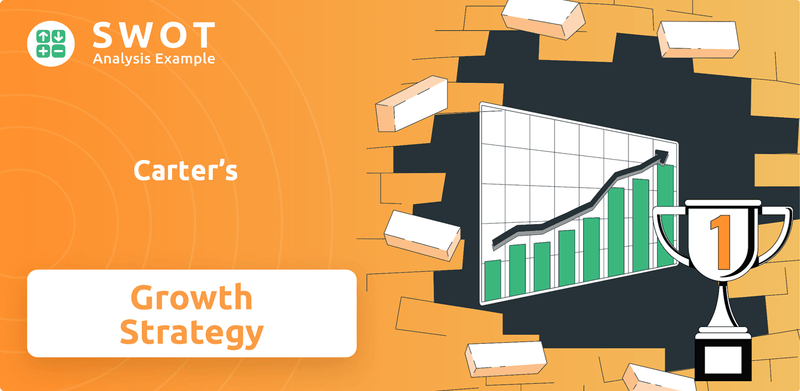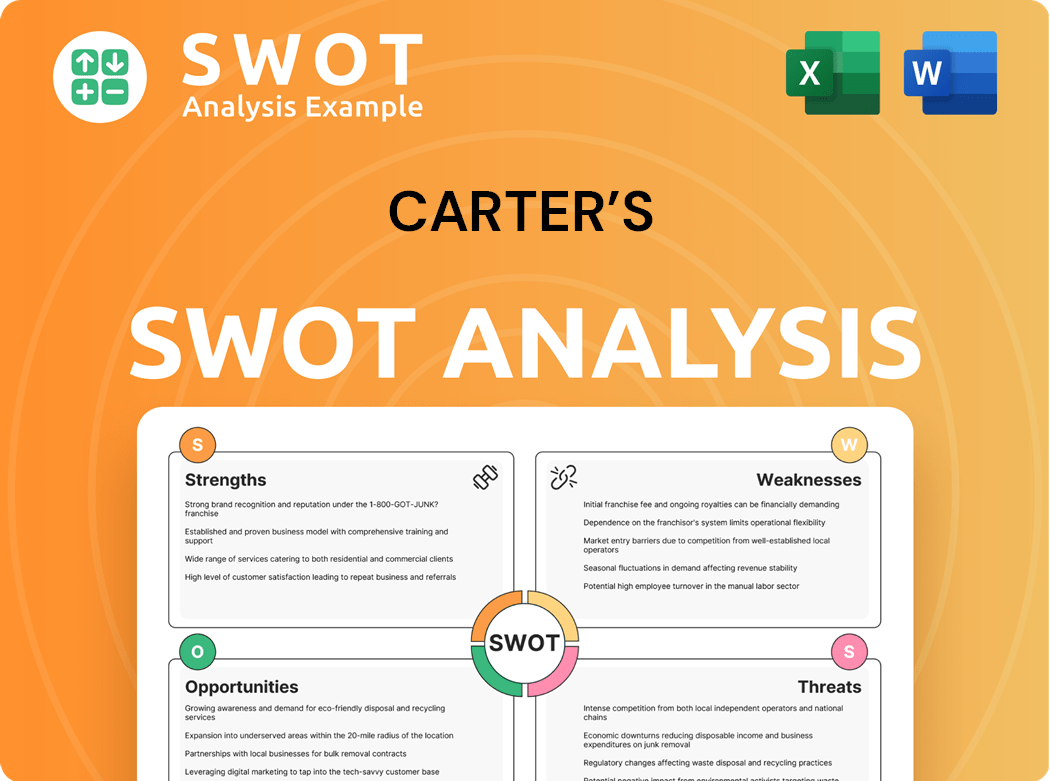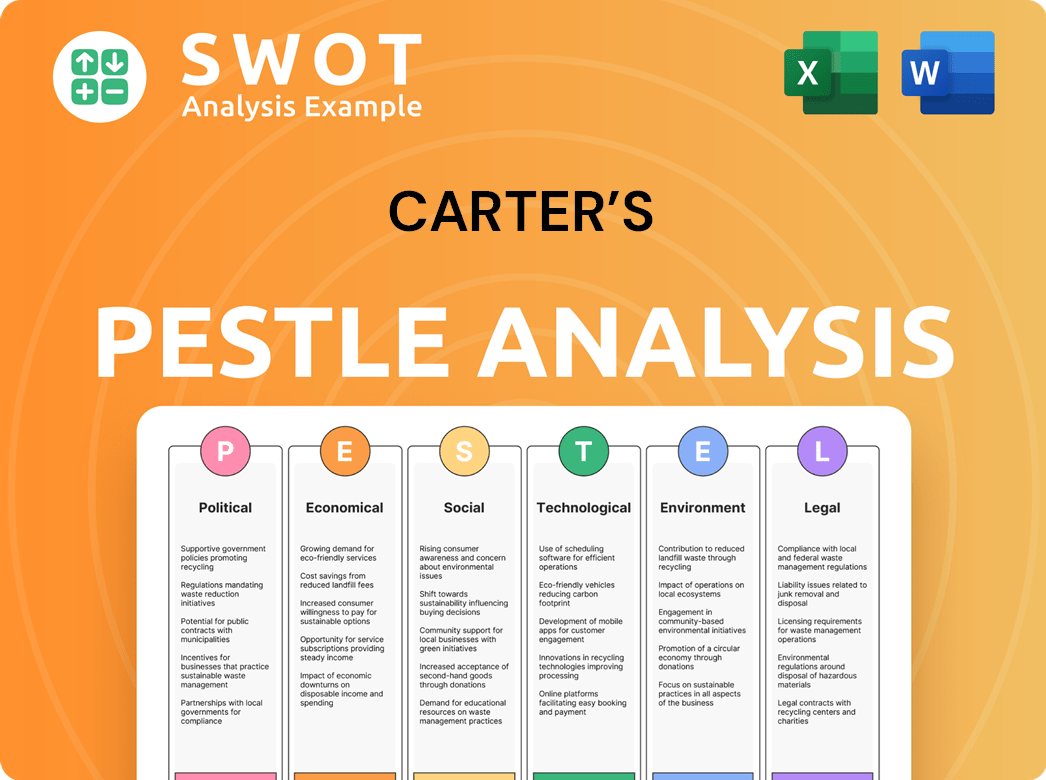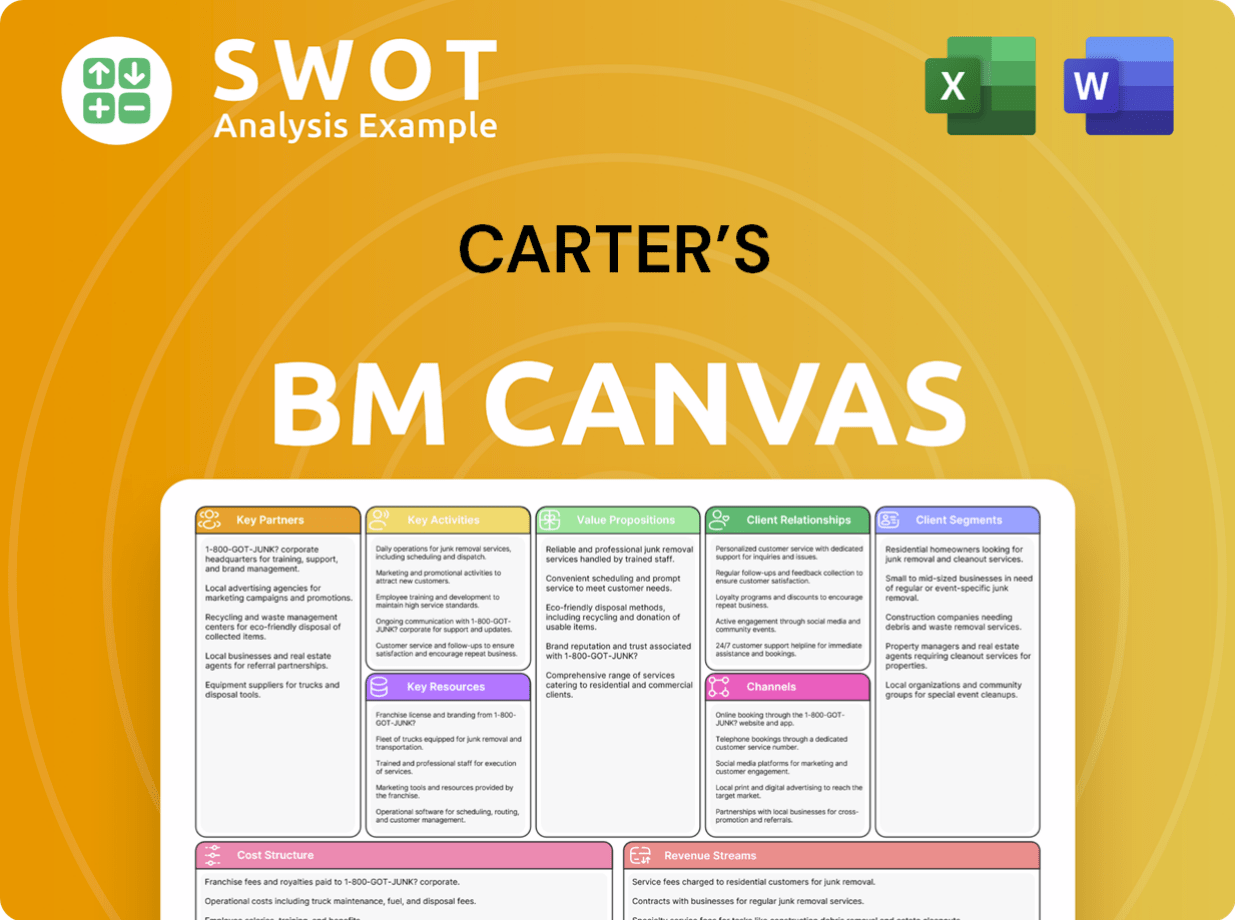Carter’s Bundle
Can Carter's Continue to Dominate the Children's Apparel Market?
From its humble beginnings in 1865, Carter's has evolved into a powerhouse in the children's apparel industry, but what does the future hold? This analysis dives deep into Carter’s SWOT Analysis, exploring its strategic initiatives and market position. We'll examine the company's growth strategy, future prospects, and how it plans to navigate the ever-changing retail industry trends.

Understanding Carter's company analysis is crucial for investors and business strategists alike, especially when considering the children's apparel market dynamics. This report will dissect Carter's expansion plans, competitive landscape, and financial performance, providing insights into its ability to capitalize on opportunities. Furthermore, we'll explore how Carter's is adapting to e-commerce and its approach to long-term growth, offering a comprehensive view of this retail giant.
How Is Carter’s Expanding Its Reach?
To understand the future of the company, it's crucial to examine its expansion initiatives. These strategies are designed to boost its market presence and diversify its offerings within the children's apparel market. A key focus involves optimizing its retail store network, a move that reflects the evolving retail industry trends.
The company is actively pursuing both new store openings and remodeling existing locations to enhance the in-store shopping experience. This approach is part of a broader strategy to adapt to changing consumer preferences and maintain a strong presence in the competitive landscape. This strategy is important for understanding the company's financial performance.
In fiscal year 2024, the company opened 41 new stores in the United States while closing 29, demonstrating a strategic adjustment to its physical footprint. The company plans to open some 250 new U.S. locations by 2027, signaling a renewed focus on brick-and-mortar retail. This commitment to physical retail is exemplified by the unveiling of its first flagship store in Atlanta in October 2024, featuring a reimagined retail experience with a Mothers' Lounge, Playhouse, Kid Interactive Zone, and gift shop, with plans for nationwide expansion of this concept by 2026.
The company is strategically adjusting its physical footprint through new store openings and remodels. This includes opening approximately 250 new U.S. locations by 2027. The first flagship store opened in Atlanta in October 2024, with plans for nationwide expansion of this concept by 2026.
The company is focused on improving product assortment and increasing marketing investments. This strategy includes expanding its 'house of brands' and increasing depth and breadth in strategic segments. The company is also modernizing its assortment to meet current market demands.
International expansion is a key component of the company's growth strategy. Strong performance has been noted in its retail businesses in Mexico and Canada. This expansion helps diversify revenue streams and tap into new markets.
The company is investing in its direct-to-consumer product offerings. Approximately $65 million was allocated in fiscal 2024 to strengthen this area. This includes $55 million towards pricing and $10 million towards brand marketing to enhance competitiveness and customer acquisition.
Beyond physical expansion, the company is also focused on product assortment improvements and marketing investments to leverage its multichannel market presence. This includes expanding its 'house of brands' and increasing depth and breadth in strategic segments and categories, with a particular emphasis on modernizing its assortment. International expansion is also a key component, with strong performance noted in its retail businesses in Mexico and Canada. The company's direct-to-consumer product offerings are also a strategic investment, with approximately $65 million allocated in fiscal 2024 to strengthen this area, including $55 million towards pricing and $10 million towards brand marketing to enhance competitiveness and customer acquisition. To gain a broader perspective on the competitive landscape, consider exploring the Competitors Landscape of Carter’s.
The company's expansion plans for 2024 and beyond focus on several key areas to drive growth and improve its market share. These initiatives are designed to adapt to retail industry trends and enhance the company's financial performance.
- Optimizing the retail store fleet through new openings and remodels.
- Improving product assortment and increasing marketing investments.
- Expanding internationally, with a focus on markets like Mexico and Canada.
- Investing in direct-to-consumer channels to enhance competitiveness.
Carter’s SWOT Analysis
- Complete SWOT Breakdown
- Fully Customizable
- Editable in Excel & Word
- Professional Formatting
- Investor-Ready Format

How Does Carter’s Invest in Innovation?
In the competitive landscape of the children's apparel market, innovation and technology are crucial for sustained growth. The company, known for its focus on children's clothing, leverages these elements to maintain its competitive edge. The company's commitment to relevant styling and premium, sustainable fabrics is a key aspect of its strategy.
A significant part of the company's strategy involves continuously innovating and creating new designs. This commitment to relevant styling and premium, sustainable fabrics is evident in the expansion of brands like Little Planet, which focuses on organic and sustainable apparel. The company also prioritizes sustainable innovation across all its brands, investing in resources like GOTS-certified organic cotton and OEKO-TEX certified baby apparel.
The company is also enhancing its digital capabilities, including new personalization features and a revamped loyalty program to boost customer engagement. Strategic investments in direct-to-consumer offerings, particularly e-commerce, highlight the importance of technology in reaching customers. The company's approach to digital transformation and improving the online shopping experience is a clear focus.
The company focuses on continuous innovation in design to resonate with its target market. This includes the development of new products and the use of sustainable materials. Brands like Little Planet, launched in 2021, emphasize organic and sustainable apparel.
The company is enhancing its digital capabilities to improve customer engagement. This involves introducing new personalization features and rebranding its loyalty program. The company's e-commerce initiatives are a key focus.
The company plans to invest approximately $65 million in capital expenditures in fiscal 2025. These investments will focus on strategic information technology initiatives, along with retail store openings, remodels, and distribution facilities. This investment supports growth objectives and efficient operations.
The company is committed to sustainable innovation across all its brands. This includes using GOTS-certified organic cotton and the largest assortment of OEKO-TEX certified baby apparel. Sustainability is a core value.
The company is investing in its direct-to-consumer offerings, including e-commerce platforms. This strategy aims to improve customer engagement and reach. The focus on online sales is a key component of its growth strategy.
While specific details on R&D investments in cutting-edge technologies like AI or IoT are not extensively detailed, the company's overall approach to digital transformation is clear. The company is focused on enhancing the online shopping experience.
The company's innovation and technology strategy is multifaceted, focusing on design, sustainability, and digital enhancements. These strategies are crucial for navigating the Brief History of Carter’s and maintaining a competitive edge in the children's apparel market. Key areas of focus include:
- Continuous design innovation to meet market demands.
- Prioritizing sustainable materials and practices across all brands.
- Enhancing digital capabilities, including personalization and loyalty programs.
- Investing in technology infrastructure to support growth and operational efficiency.
- Focusing on direct-to-consumer offerings, particularly e-commerce.
Carter’s PESTLE Analysis
- Covers All 6 PESTLE Categories
- No Research Needed – Save Hours of Work
- Built by Experts, Trusted by Consultants
- Instant Download, Ready to Use
- 100% Editable, Fully Customizable

What Is Carter’s’s Growth Forecast?
The financial landscape for Carter's reflects a period of adjustment and strategic recalibration. The company's performance in fiscal year 2024 and the initial quarter of fiscal 2025 indicates shifts in revenue, profitability, and shareholder returns. This analysis provides a detailed look at the financial trends, future projections, and strategic decisions influencing Carter's trajectory in the competitive children's apparel market.
Carter's financial performance in fiscal year 2024 revealed a decrease in net sales to $2.844 billion, down from $2.946 billion in 2023. The operating margin also declined to 9.0% from 11.0% in the previous year. Adjusted operating margin followed a similar trend, falling to 10.1% from 11.1%. These figures highlight the challenges Carter's faced in maintaining its financial strength.
In the first quarter of fiscal 2025, Carter's reported a 4.8% decrease in net sales, totaling $629.8 million compared to $661.5 million in the same period of fiscal 2024. This decline in the children's apparel market, coupled with reduced earnings per share (EPS), indicates ongoing pressures. The company's strategic responses, including dividend adjustments and paused share repurchases, reflect efforts to navigate these financial headwinds.
Net sales decreased to $2.844 billion from $2.946 billion in 2023, indicating a slight decline in revenue. Operating margin decreased to 9.0% from 11.0%, and adjusted operating margin fell to 10.1% from 11.1%, reflecting reduced profitability. Diluted EPS was $5.12, down from $6.24 in 2023, while adjusted diluted EPS was $5.81, compared to $6.19 in 2023.
Net sales for Q1 2025 were $629.8 million, a 4.8% decrease from $661.5 million in Q1 2024. Diluted EPS was $0.43, down from $1.04 in Q1 2024, and adjusted diluted EPS was $0.66 compared to $1.04 in Q1 2024. The company returned $29 million to shareholders through dividends during the first quarter of 2025.
For fiscal year 2025, Carter's projects net sales between $2.780 billion and $2.855 billion. Adjusted operating income is expected to range from $180 million to $210 million, and adjusted diluted EPS is projected to be between $3.20 and $3.80. S&P Global Ratings revised its outlook to negative, citing declining profitability.
The company reduced its quarterly dividend by almost 70% to $0.25 per share, effective June 2025, and paused share repurchases. A new strategic plan is expected to be shared in late July during the second quarter earnings call, reflecting a shift to anticipate significant investments and current profitability levels. These moves are part of Carter's growth strategy.
In June 2025, S&P Global Ratings revised its outlook for Carter's to negative from stable. This revision reflects concerns about declining profitability and increased pressure on revenue and EBITDA. S&P Global Ratings anticipates a mid-single-digit percentage decline in reported revenue for 2025 and a decline of more than 35% in adjusted EBITDA. The company's strategic decisions, such as the dividend cut and pause on share repurchases, are aimed at navigating these challenges and positioning the company for future growth.
Carter's is adapting to changing market conditions by adjusting its financial strategies. The company's focus on cost management and strategic investments is crucial for maintaining its market position. Understanding the Target Market of Carter’s is essential for the company's future prospects.
- Revenue Decline: Anticipated mid-single-digit percentage decline in 2025.
- EBITDA Impact: Adjusted EBITDA expected to decline by more than 35% in 2025.
- Dividend Reduction: Quarterly dividend cut by almost 70% to $0.25 per share.
- Strategic Plan: New plan expected in late July to address leadership transition and tariff uncertainties.
Carter’s Business Model Canvas
- Complete 9-Block Business Model Canvas
- Effortlessly Communicate Your Business Strategy
- Investor-Ready BMC Format
- 100% Editable and Customizable
- Clear and Structured Layout

What Risks Could Slow Carter’s’s Growth?
The growth strategy of Carter's faces several risks and obstacles. These challenges include intense competition in the children's apparel market, economic pressures, and supply chain vulnerabilities. Understanding these risks is crucial for a comprehensive Carter's company analysis and assessing its future prospects.
Economic factors like inflation and interest rates have affected consumer spending, potentially reducing demand for Carter's products. Additionally, the company deals with increased product costs, partly due to tariffs and supply chain issues. These factors require careful management to maintain or improve Carter's financial performance.
Changes in demographics, such as flat or slightly declining birth rates in the U.S., could also limit growth opportunities for Carter's. The company's ability to navigate these challenges will be critical for its long-term growth forecast and investment opportunities.
The children's apparel market is highly competitive, with numerous brands and private labels vying for market share. Competition is based on factors such as product quality, brand recognition, price, and service. This competitive landscape impacts Carter's market share analysis and overall performance.
Inflation and higher interest rates have reduced consumer confidence and spending. This economic climate leads to decreased demand for discretionary items like children's clothing. Carter's must adapt to these retail industry trends to maintain sales.
Supply chain disruptions and rising costs, including tariffs, negatively affect Carter's. Efficient cost management and supply chain optimization are essential to mitigate these impacts. The company's sourcing strategy plays a critical role in managing these risks.
Flat or declining birth rates in the U.S. pose a challenge to growth. This demographic shift requires Carter's to consider new strategies for expansion plans 2024 and long-term growth. Adapting to changing demographics is vital for sustainable growth.
Diversifying the sourcing network to reduce tariff impacts can introduce operational complexities. Managing a more varied supply chain requires careful coordination and potentially increases costs. This diversification is a key aspect of Carter's international market strategy.
The recent suspension of forward guidance due to leadership transitions and uncertainties highlights the need for strategic reassessment. Re-evaluating strategies and returning to consistent, profitable growth are critical. Understanding Revenue Streams & Business Model of Carter’s provides insights into the company's financial health.
Carter's is focusing on cost management and operational efficiencies to strengthen its offerings and sharpen price points. This approach is critical to improve Carter's financial performance and maintain competitiveness. This strategy is essential for navigating the current economic conditions.
Diversifying the sourcing network is a key strategy to mitigate tariff impacts. With a significant portion of finished goods sourced from a few countries, the company aims to reduce its exposure to trade-related risks. This diversification effort is part of Carter's supply chain optimization.
Carter's has demonstrated resilience in challenging market conditions, but a turnaround will take time. The current macroeconomic environment requires a strategic reassessment. Understanding retail industry trends is key to adapting to these challenges.
The suspension of forward guidance underscores the need for strategic adjustments. This includes re-evaluating strategies to return to consistent, profitable growth. This reassessment is critical for long-term success and investment opportunities.
Carter’s Porter's Five Forces Analysis
- Covers All 5 Competitive Forces in Detail
- Structured for Consultants, Students, and Founders
- 100% Editable in Microsoft Word & Excel
- Instant Digital Download – Use Immediately
- Compatible with Mac & PC – Fully Unlocked

Related Blogs
- What are Mission Vision & Core Values of Carter’s Company?
- What is Competitive Landscape of Carter’s Company?
- How Does Carter’s Company Work?
- What is Sales and Marketing Strategy of Carter’s Company?
- What is Brief History of Carter’s Company?
- Who Owns Carter’s Company?
- What is Customer Demographics and Target Market of Carter’s Company?
Disclaimer
All information, articles, and product details provided on this website are for general informational and educational purposes only. We do not claim any ownership over, nor do we intend to infringe upon, any trademarks, copyrights, logos, brand names, or other intellectual property mentioned or depicted on this site. Such intellectual property remains the property of its respective owners, and any references here are made solely for identification or informational purposes, without implying any affiliation, endorsement, or partnership.
We make no representations or warranties, express or implied, regarding the accuracy, completeness, or suitability of any content or products presented. Nothing on this website should be construed as legal, tax, investment, financial, medical, or other professional advice. In addition, no part of this site—including articles or product references—constitutes a solicitation, recommendation, endorsement, advertisement, or offer to buy or sell any securities, franchises, or other financial instruments, particularly in jurisdictions where such activity would be unlawful.
All content is of a general nature and may not address the specific circumstances of any individual or entity. It is not a substitute for professional advice or services. Any actions you take based on the information provided here are strictly at your own risk. You accept full responsibility for any decisions or outcomes arising from your use of this website and agree to release us from any liability in connection with your use of, or reliance upon, the content or products found herein.